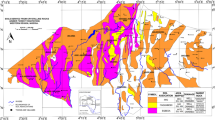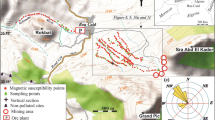Abstract
Soils formed after the desiccation of Lake Atamanskoe, which has served as a reservoir for liquid industrial waste from the city of Kamensk-Shakhtinsky during a long time, were studied. These soils differ from zonal soils by a strong contamination with zinc and sulfur. Preliminary studies showed that Fe compounds fix a significant part of zinc. This requires to study S, Zn, and Fe minerals. In this work, Mössbauer spectroscopy was used for the identification of iron compounds and scanning electron microscopy was used for the microanalysis of these and other minerals. To facilitate the identification of Fe minerals, brown iron ocher was removed from a contaminated soil sample and analyzed. From electron microscopy and Mössbauer spectroscopy data, ocher contained hydrogoethite with a high content of sorption water and schwertmannite (a rare mineral, probably found in Russia for the first time). The chemical composition of this schwertmannite better corresponds to the Cashion–Murad model than to the Bigham model. Particles of partially oxidized magnetite and wustite enriched with zinc were revealed under electron microscope. Siderite with partial substitution of Fe2+ by Zn2+ was detected. Thus, contaminated hydromorphic soil contains both common minerals (illite, goethite, hematite, gypsum) and rare minerals (schwertmannite, Zn siderite, partially oxidized magnetite and wustite enriched with zinc).






Similar content being viewed by others
References
Acero, P., Ayora, C., Torrento, C., & Nieto, J. M. (2006). The behavior of trace elements during schwertmannite precipitation and subsequent transformation into goethite and jarosite. Geochimica et Cosmochimica Acta,70, 4130–4139.
Angelico, R., Ceglie, A., Ji-Zheng, H., Yu-Rong, L., Palumbo, G., & Colombo, C. (2014). Particle size, charge and colloidal stability of humic acids coprecipitated with ferrihydrite. Chemosphere,99, 239–347.
Bagin, B. I., Gendler, T. S., & Avilova, T. A. (1988). Magnetism of iron α-oxides and hydroxides. Moscow: Akademiya Nauk SSSR.
Barham, R. J. (1997). Schwertmannite: A unique mineral, contains a replaceable ligand, transforms to jarosites, hematites, and/or basic iron sulfate. Journal of Materials Research,12, 2751–2758.
Bedanta, S., & Kleemann, W. (2009). Supermagnetism. Journal of Physics D: Applied Physics,42, 013001.
Bigham, J. M., Carlson, L., & Murad, E. (1994). Schwertmannite, a new iron oxyhydroxysulphate from Pyhasalmi, Finland, and other localities. Mineralogical Magazine,58, 641–648.
Bigham, J. M., Schwertmann, U., Carlson, L., & Murad, E. (1990). A poorly crystalli-zed oxyhydroxysulfate of iron formed by bacterial oxidation of Fe(II) in acid-mine waters. Geochimica et Cosmochimica Acta,54, 2743–2758.
Bigham, J. M., Schwertmann, U., Traina, S. J., Winland, R. L., & Wolf, M. (1996). Schwertmannite and the chemical modeling of iron in acid sulfate waters. Geochimica et Cosmochimica Acta,60, 2111–2121.
Burton, E. D., Bush, R. T., Sullivan, L. A., & Mitchell, D. R. G. (2007). Reductive transformation of iron and sulfur in schwertmannite-rich accumulations associated with acidified coastal lowlands. Geochimica et Cosmochimica Acta,71, 4456–4473.
Cashion, J. D., & Murad, E. (2012). Mössbauer spectra of the acid mine drainage mineral schwertmannite from the Sokolov basin, Czech Republic. In Proceedings of the 36th annual condensed matter and materials meeting, Wagga, NSW, Australia, TP30:1–TP30:4.
Cui, M., Jang, M., Cho, S.-H., & Khim, J. (2011). Potential application of sludge produced from coal mine drainage treatment for removing Zn(II) in an aqueous phase. Environmental Geochemistry and Health,33, 103–112. https://doi.org/10.1007/s10653-010-9348-0.
Fernandez-Martinez, A. V., Nimon, V., Roman-Ross, G., Cuello, G. J., Daniels, J. E., & Ayora, C. (2010). The structure of schwertmannite, a nanocrystalline iron oxyhydroxysulfate. American Mineralogist,95, 1312–1322.
Frye, K. (Ed.). (1983). The encyclopedia of mineralogy. Berlin: Springer.
Gagliano, W. B., Brill, M. R., Bigham, J. M., Jones, F. S., & Traina, S. J. (2004). Chemistry and mineralogy of ochreous sediments in a constructed mine drainage wetland. Geochimica et Cosmochimica Acta,68, 2119–2128.
ISO 10381-1. (2002). Soil quality. Sampling. Part 1. Guidance on the Design of Sampling Programs.
ISO Guide 34. (2009). General Requirements for the Competence of Reference Material Producers.
Ivanov, A. V. (2003). Magnetic and valent state of iron in soil solid phase. Doctoral (Biology) Dissertation, Moscow: Moscow State University.
Kudryavtseva, G. P. (1988). Ferrimagnetism of natural oxides. Moscow: Nedra.
Lu, W., Lin, Ch., & Ma, Yi. (2013). Long-term geochemical evolution of acidic mine wastes under anaerobic conditions. Environmental Geochemistry and Health,35, 523–533. https://doi.org/10.1007/s10653-013-9512-4.
Manceau, A., Lanson, B., Schlegel, M. L., Harge, J. C., Musso, M., Eybert-Berard, L., et al. (2000). Quantitative Zn speciation in smelter-contaminated soils by EXAFS spectroscopy. American Journal of Science,300, 289–343.
Manceau, A., Marcus, M. A., Tamura, N., Proux, O., Geoffroy, N., & Lanson, B. (2004). Natural speciation of Zn at the micrometer scale in a clayey soil using X-ray fluorescence, absorption, and diffraction. Geochimica et Cosmochimica Acta, 68(11), 2467–2483. https://doi.org/10.1016/j.gca.2003.11.021.
Manceau, A., Tamura, N., Celestre, R. S., Macdowell, A. A., Geoffroy, N., Sposito, G., et al. (2003). Molecular-scale speciation of Zn and Ni soil ferromanganese nodules from loess soils of the Mississippi Basin. Environmental Science and Technology,37, 75–80.
Matsnev, M. E., & Rusakov, V. S. (2012). SpectrRelax: An application for Mössbauer spectra modeling and fitting. American Institute of Physics Conference Proceedings,1489, 178–185.
Minkina, T., Nevidomskaya, D., Bauer, T., Shuvaeva, V., Soldatov, A., Mandzhieva, S., et al. (2018). Determining the speciation of Zn in soils around the sediment ponds of chemical plants by XRD and XAFS spectroscopy and sequential extraction. Science of the Total Environment,634, 1165–1173.
Murad, E. (2010). Mössbauer spectroscopy of clays, soils and their mineral constituents. Clay Minerals,45, 413–430.
Murad, E., & Wagner, U. (1994). The Mössbauer spectrum of illite. Clay Minerals,26, 1–10.
Pankratov, D. A. (2014). Mössbauer study of oxo derivatives of iron in the Fe2O3-Na2O2 system. Inorganic Materials,50, 82–89.
Parafiuk, J., & Siuda, R. (2006). Schwertmannite precipitated from acid mine drainage in the Western Sudetes (SW Poland) and its arsenate sorption capacity. Geological Quarterly,50(4), 475–486.
Privalenko, V. V., Mazurenko, V. T., Panaskov, V. I., Moshkin, V. M., Mukhin, N. V., & Senin, B. K. (2000). Ecological problems in the city of Kamensk-Shakhtinsk. Rostov-on-Don: Tsvetnaya pechat’.
Pronina, V. V. (2007). Formation of magnetic iron oxides in soils at the underground storage of natural gas. Candidate (Biology) Dissertation. Moscow: Moscow State University.
Roden, E. E., & Zachara, J. M. (1996). Microbial reduction of crystalline Fe(III) oxides: Influence of oxide surface area and potential for cell growth. Environmental Science and Technology,30, 1618–1628.
Shoba, S. A. (2007). Morphogenesis of taiga-zone soils. Moscow: NIA-Priroda.
Sokolova, T. A., Dronova, T. Ya., Tolpeshta, I. I. (2005). Clay minerals in soils. Tula: Grif.
Van der Zee, C., Roberts, D. R., Rancourt, D. G., & Stomp, C. P. (2003). Nanogoethite is the dominant reactive oxyhydroxide phase in lake and marine sediments. Geology,31, 993–996.
Vandenberghe, R. E., & De Grave, E. (2013). Chapter 3. Application of Mössbauer spectroscopy in earth sciences. In Y. Yoshida & G. Langouche (Eds.), Mössbauer spectroscopy (pp. 91–185). Berlin: Springer.
Vodyanitskii, Yu. N., Minkina, T. M., Kubrn, S. P., Linnik, V. G. (2018). Iron sulphides and their effect on the XRF measurement of the bulk chemical composition of badland soils near the Karabash copper smelter, Southern Urals, Russia. Geochemistry: Exploration, Environment, Analysis. https://doi.org/10.1144/geochem2017-081.
Vorob’eva, L. A. (2006). Theory and practice chemical analysis of soils. Moscow: GEOS.
Wagner, F. E., & Wagner, U. (2004). Mössbauer spectra of clays and ceramics. Hyperfine Interactions,154, 35–82.
Yu, J. Y., Heo, B., Choi, I. K., Cho, J. P., & Chang, H. W. (1999). Apparent solubilities of schwertmannite and ferrihydrite in natural stream waters polluted by mine drainage. Geochimica et Cosmochimica Acta,63, 3407–3416.
Zagurskii, A. M. (2008). Specific macrostructure and genesis of magnetic iron compound sin soils. Candidate (Biology) Dissertation, Moscow: Moscow State University.
Zahid, A., Hassan, M. Q., Breit, G. N., Balke, K.-D., & Flegr, M. (2009). Accumulation of iron and arsenic in the Chandina alluvium of the lower delta plain, Southeastern Bangladesh. Environmental Geochemistry and Health,31, 69–84. https://doi.org/10.1007/s10653-008-9226-1.
Zavarzina, N. G. (2001). Biogeochemical factors of iron compound transformation under reducing conditions. Candidate (Geology, Mineralogy) Dissertation, Moscow: Moscow State University.
Acknowledgements
This work was supported by the Ministry of Education and Science of Russia, Project No. 5.948.2017/PCh, Russian Academy of Sciences, Project No. AAAA-A19-119011190176-7.
Author information
Authors and Affiliations
Corresponding author
Ethics declarations
Conflict of interest
The authors declare that they have no conflict of interest.
Additional information
Publisher's Note
Springer Nature remains neutral with regard to jurisdictional claims in published maps and institutional affiliations.
Rights and permissions
About this article
Cite this article
Vodyanitskii, Y.N., Minkina, T.M., Kubrin, S.P. et al. Common and rare iron, sulfur, and zinc minerals in technogenically contaminated hydromorphic soil from Southern Russia. Environ Geochem Health 42, 95–108 (2020). https://doi.org/10.1007/s10653-019-00295-6
Received:
Accepted:
Published:
Issue Date:
DOI: https://doi.org/10.1007/s10653-019-00295-6




